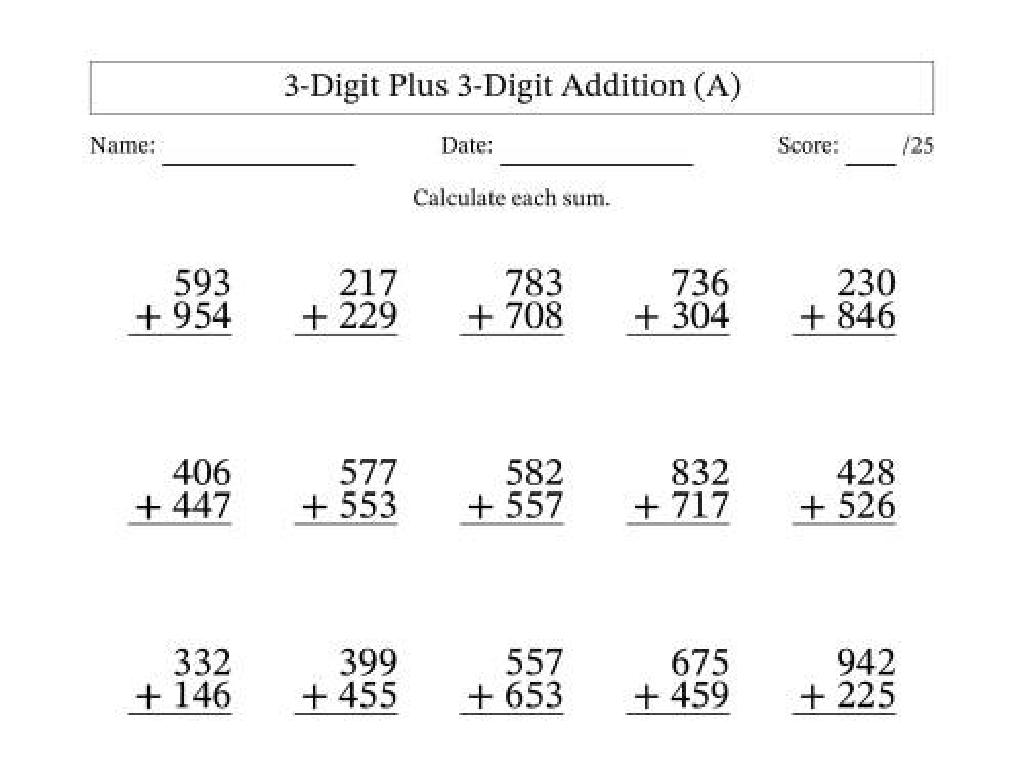Identify Adjectives
Subject: Language arts
Grade: Sixth grade
Topic: Adjectives And Adverbs
Please LOG IN to download the presentation. Access is available to registered users only.
View More Content
Welcome to Adjectives!
– Understanding adjectives
– Adjectives are words that describe nouns or pronouns.
– The role of adjectives in sentences
– They add detail and make our sentences more interesting.
– Today’s objective: Identifying adjectives
– We’ll learn how to spot adjectives in a sentence.
|
This slide introduces the concept of adjectives to the students. Begin by explaining that adjectives are descriptive words that modify nouns or pronouns, giving more information about an object’s size, shape, age, color, origin, or material. Emphasize why adjectives are crucial: they enhance writing by allowing us to create vivid and precise sentences. Today’s goal is to equip students with the ability to identify adjectives in various sentences. Use examples to illustrate how adjectives change the meaning and provide clarity. Encourage students to think of adjectives as the coloring tools that bring a picture (sentence) to life.
Exploring Adjectives
– Adjectives describe nouns
– Words that give more information about a noun
– They specify kind, quantity, or identity
– ‘Kind’ refers to qualities, ‘how many’ to number, ‘which one’ to specific identity
– Examples: ‘blue’ sky, ‘five’ cookies
– ‘Blue’ tells us the color of the sky, ‘five’ indicates the number of cookies
– Practice: Identify adjectives in sentences
– Find and highlight adjectives in provided sentences
|
This slide introduces the concept of adjectives to the students. Begin by explaining that adjectives are words used to add detail and describe nouns, making our sentences richer and more informative. They can tell us the kind of thing we’re talking about, the number of things, or specify exactly which thing we mean. Use clear examples like ‘blue sky’ to describe color, ‘five cookies’ to indicate quantity, and ‘that book’ to point out a specific item. After explaining, engage the students with a practice activity where they identify adjectives in sample sentences. This will help them apply what they’ve learned and understand how adjectives function within the context of a sentence.
Exploring Types of Adjectives
– Descriptive Adjectives: express qualities
– Examples: ‘happy’, ‘sad’, ‘bright’
– Quantitative Adjectives: indicate quantity
– Examples: ‘several’, ‘many’, ‘few’
– Demonstrative Adjectives: point out specific items
– Examples: ‘this’, ‘that’, ‘these’, ‘those’
– Practice identifying each type
|
This slide introduces students to the different types of adjectives. Descriptive adjectives are used to describe a noun’s qualities, such as ‘happy’ for mood or ‘bright’ for appearance. Quantitative adjectives show the amount or quantity of nouns, like ‘many’ or ‘few’. Demonstrative adjectives are used to point out specific nouns, such as ‘this book’ or ‘those apples’. Encourage students to come up with their own examples and to practice identifying the types of adjectives in sentences. This will help them understand how adjectives can modify nouns and make their writing more descriptive and precise.
Identifying Adjectives in Sentences
– Read sentences attentively
– Search for descriptive words
– Adjectives give more information about nouns
– Underline the adjectives
– This helps to spot them easily
– Practice with examples
– ‘The fluffy cat sat on the mat.’ – ‘fluffy’ describes ‘cat’
|
This slide is aimed at teaching students how to identify adjectives within sentences. Start by instructing students to read sentences with full attention to detail. Explain that adjectives are words that describe or modify nouns, giving us more information about the object, person, place, or idea that the noun represents. Encourage students to look for words that add detail to the nouns and underline them as they read. Provide several examples and have students practice by reading sentences and identifying the adjectives. For instance, in the sentence ‘The fluffy cat sat on the mat,’ the word ‘fluffy’ is an adjective describing the noun ‘cat.’ This exercise will help students understand the role of adjectives in adding richness to language.
Let’s Practice Together: Spot the Adjectives!
– Identify adjectives in sentences
– Adjectives describe nouns
– Words that tell us more about nouns
– ‘Large’, ‘brown’ describe the dog
– Size and color adjectives for the dog
– ‘Beautiful’, ‘long’, ‘red’ describe the dress
– Qualitative and color adjectives for the dress
|
This slide is an interactive class activity designed to help students practice identifying adjectives within the context of a sentence. Adjectives are words that describe or modify nouns, giving us more information about the object’s size, color, quantity, or quality. Encourage the students to look for words that add detail to the nouns in the sentences. For example, ‘large’ and ‘brown’ give us a clearer picture of the dog, while ‘beautiful’, ‘long’, and ‘red’ help us visualize the dress. Have students come up with additional sentences and identify the adjectives used. This activity will reinforce their understanding of adjectives and improve their descriptive writing skills.
Your Turn to Identify Adjectives!
– Find adjectives on the worksheet
– Underline the adjectives you find
– Share your findings with a partner
– Exchange worksheets and compare adjectives identified
– Discuss your adjective choices
– Explain why each underlined word is an adjective
|
This slide initiates a class activity focused on identifying adjectives. Students should individually locate and underline adjectives in the sentences provided on their worksheets. After completing this task, they will pair up with a classmate to share and compare their answers, fostering peer learning. The discussion phase is crucial as it encourages students to articulate their understanding of adjectives and justify their choices, reinforcing their grasp of the concept. As a teacher, circulate the room to offer guidance and ensure that students are correctly identifying adjectives. Be prepared to provide examples and further clarification if needed. This activity not only solidifies the students’ knowledge of adjectives but also enhances their collaborative and critical thinking skills.
Class Activity: Adjective Hunt
– Form small groups for the hunt
– Find objects in the classroom
– Use two adjectives to describe each
– Example: ‘The glossy, red apple sits on the teacher’s desk.’
– Write down your descriptive sentences
|
This activity is designed to reinforce the students’ understanding of adjectives through a practical and interactive exercise. Divide the class into small groups and instruct them to look around the classroom for any object they can describe. Encourage them to use at least two adjectives for each object they select. This will help them to think critically about the properties of the objects and how best to describe them. Once they have their adjectives, have them write down the sentences they’ve created. After the activity, each group can share their sentences with the class, and the class can discuss the adjectives used. Possible variations of the activity could include finding adjectives in a text, describing classmates in a respectful way, or using adjectives to write a short story.
Review and Closing: Adjectives
– Recap on adjectives
– Adjectives describe nouns, giving detail.
– Significance of adjectives
– They add color and interest to our sentences.
– Homework: Craft sentences
– Write 10 sentences using various adjectives.
– Share in next class
– Be ready to present your sentences.
|
As we wrap up today’s lesson, let’s review what we’ve learned about adjectives. They are words that describe or modify nouns and pronouns, providing more detail and allowing us to visualize or understand the noun better. Adjectives enhance our writing by making it more vivid and precise. For homework, students are to write ten sentences, each incorporating a different adjective. This will help reinforce their understanding of how adjectives function within a sentence. In the next class, we’ll share some of these sentences to discuss the effectiveness of the adjectives used and how they change the meaning or imagery of the sentence.





